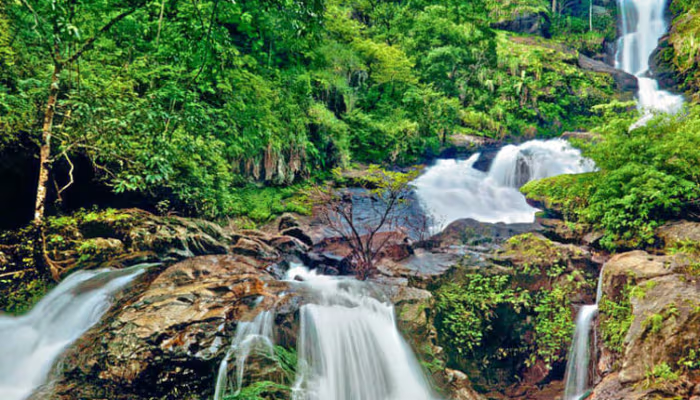Lakshmana Tirtha River
|
About:
|

The Lakshmana Tirtha River is a small but significant river that flows
through the southern part of Karnataka, India. Known for its historical and
mythological significance, this river is a tributary of the Kaveri River and
is revered by locals for its sacred association with Hindu mythology. The
river flows through picturesque landscapes, including dense forests, coffee
plantations, and charming villages, and is essential to the region’s ecology
and water supply. The river is also a vital source of irrigation, supporting
agriculture in the surrounding areas.
|
Location info:
|
| The Lakshmana Tirtha River originates in the Brahmagiri Hills of the Western
Ghats in Karnataka, near the town of Kutta in Kodagu (Coorg) district. It flows
southward, passing through the town of Srimangala and joining the Kaveri River
near the town of Hunsur in the Mysore district.
|
Climate/Weather:
|
| The climate in the river’s region is tropical, with heavy monsoons from June to
September and mild, pleasant winters from November to February. Summers can be
warm, with temperatures ranging from 25°C to 35°C, while winter temperatures
generally range between 15°C and 25°C.
|
History:
|
| The Lakshmana Tirtha River holds a prominent place in Hindu mythology, closely
tied to the epic Ramayana. According to legend, Lakshmana, the brother of Lord
Rama, created the river by shooting an arrow into the earth to provide water for
Sita, who was thirsty during their forest exile. This act led to the formation
of the Lakshmana Tirtha, which has since been considered sacred. Over centuries,
the river has remained an essential water source and a site of religious
significance for devotees who visit the temples along its banks. The river’s
banks are dotted with various temples and sacred spots where devotees perform
rituals, bathe, and offer prayers. The surrounding Kodagu region has a rich
history of local kings and tribal communities who considered the river as a
life-giving force for agriculture and daily life. The Lakshmana Tirtha thus
symbolizes both the religious and cultural heritage of Karnataka and stands as a
testament to the region’s deep-rooted mythology and traditions.
|
Interesting things to do:
|
| River Bathing: Visitors often take a holy dip in the river, particularly near
temples.
Trekking: The river’s course through the Brahmagiri Hills offers scenic trails
for trekking.
Nature Photography: Capture the river’s picturesque flow through forests and
villages. |
Interesting things to Visit:
|
| Irupu Falls: A beautiful waterfall on the Lakshmana Tirtha, known for its
stunning natural surroundings.
Brahmagiri Wildlife Sanctuary: Located nearby, it’s ideal for wildlife
enthusiasts and bird watchers. |
Mobile range info:
|
| Mobile connectivity is generally available near towns and larger villages along
the river, but coverage may be weak or unavailable in deeper forested areas near
its origin.
|
How to reach?
|
| Nearest Railway Station:Mysore Railway Station, about 80 km away, is the
nearest major railway station.
|
| Nearest Airport: The closest airport is Kannur International Airport,
approximately 120 km away, and Mysore Airport is around 80 km away.
|
| Road Transport:The nearest town, Kutta, is well-connected by road from
Madikeri and Mysore. |
Nearest Visiting places:
|
| Nagarhole National Park: Known for its rich biodiversity and opportunities for wildlife spotting.
Madikeri: The main town in Kodagu, famous for its coffee plantations and Raja’s Seat viewpoint.
Iruppu Falls: A sacred spot in south Kodagu in the Brahmagiri hill range. The
Lakshmana Tirtha River flows nearby. Legend says that Rama and Lakshmana
passed this way while searching for Sita. Sri Rama asked Lakshmana to fetch
some drinking water for him. Lakshmana shot an arrow into the Brahmagiri
hills and brought into being the river Lakshmanatirtha. The river descends
into a cataract known as the Iruppu Falls. This place is said to possess the
power to cleanse one's sins and is visited by thousands of devotees on
Shivaratri day.
Abbey Falls: a scenic waterfall 5 km from Madikeri.
Dubare: mainly an elephant-capturing and training camp of the Forest
Department at the edge of Dubare forest; on the bank of the river Kaveri
along the Kushalanagara - Siddapur road.
|
Nearest Petrol Pump:
|
| The closest petrol pumps are in Kutta and Srimangala, about 10-20 kilometers from different points along the river.
|
Hotels/Lodge/Accommodation:
|
| Accommodations are available in Kutta, Srimangala, and Madikeri, ranging from budget homestays to mid-range hotels. The region also offers nature resorts and forest lodges for a closer experience with nature.
|
Things to carry:
|
| Water Bottles: Essential for hydration, especially if trekking along the river.
Binoculars: Useful for birdwatching, particularly in forested areas.
Sunscreen and Hat: The sun can be strong, so protection is necessary.
Insect Repellent: Helpful to avoid insect bites in forested regions.
Comfortable Footwear: Ideal for trekking or exploring trails along the river. |
Tips & Suggestions:
|
| Best Time to Visit: The post-monsoon and winter seasons (October to February) are ideal, as the river is full and the weather is pleasant.
Safety Precautions: Exercise caution while trekking or walking near the riverbanks, especially during monsoons when the current can be strong.
Respect Local Customs: Many places along the river have religious significance, so dress modestly and follow local customs.
Wildlife Awareness: Be aware of your surroundings in forested areas, as the region is home to diverse wildlife. |
Help Line/Phone Number:
|
| Kodagu District Forest Office:+91-8272-221402. |












